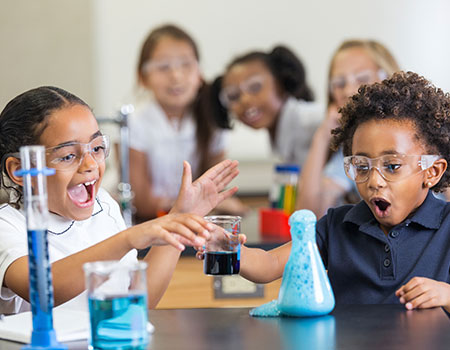

Inventors- 3rd To 4th Grade
Students in this age group have a lot of enthusiasm for science and learning. We cater to that enthusiasm by using active learning through a combination of hands-on activities, interactive materials, and illustration of concepts. At this age, the most important thing is to develop the excitement about science which will lead them into a desire for continuing to learn in more formal classes later on. While our atmosphere is informal and fun, there are deep concepts being laid down concerning scientific ways of thinking, and connections between experiments in class and real world applications.
** A word about grade levels. For the most part, students who come to us for more science instruction in 3rd-8th grade are already advanced in knowledge and ability. Our small class sizes allow our instructors to modify lesson plans, and use materials that are “ahead” of the public school curriculum levels. You can be confident that your student will learn and achieve at a level which is appropriate for them as individuals. We can’t wait to meet them!
DETAILS :
We will conduct 60 minutes session every week in Fall of 2024. The 60-minute session is divided into theory followed by a hands-on experiment. Lessons are conducted in a live instructor-led learning environment, with abundant opportunities to explore and interact with their peers. For Fall 2024, classes will start from September 28th and will run through December 21st. There will be total 12 sessions for the Fall Semester and we will cover topics which align with NGSS standard for the grade level. For a detail of the topics, please click on the Lessons Tab. All Sessions are conducted in-person and limited to 6 students per class only. .
| Lesson Plans | NGSS Standard | Standard Description |
|---|---|---|
| What is science? How do we know things? | Video and discussion of what areas scientists and engineers study, and discussion with students about what areas of science fascinate them. | |
| How does a solar system form? | 5-ESS1-1 | Support an argument that the apparent brightness of the sun and stars is due to their relative distances from the Earth. |
| What kinds of planets are there? Different bodies in the solar system | 5-ESS1-2 | Represent data in graphical displays to reveal patterns of daily changes in length and direction of shadows, day and night, and the seasonal appearance of some stars in the night sky. |
| Astrobiology, what makes a planet livable? Design your own planet activity | 5-ESS2-1 | Develop a model using an example to describe ways the geosphere, biosphere, hydrosphere, and/or atmosphere interact. |
| Seeing the phases of the moon, and eclipses | 6.MS-ESS1-1a | Represent data in graphical displays to reveal patterns of daily changes in length and direction of shadows, day and night, and the seasonal appearance of some stars in the night sky. |
| Seasons, the amount of daylight on earth affects the climate | 3-ESS2-1 | Represent data in tables and graphical displays to describe typical weather conditions expected during a particular season. |
| Types of energy, how energy is transferred | 4-PS3-1, 2, 3 4-ESS3-1 | Make observations to provide evidence that energy can be transferred from place to place by sound, light, heat, and electric currents. |
| how mechanical energy can be used | 4-PS3-4 | Use evidence to construct an explanation relating the speed of an object to the energy of that object. |
| electricity, electric circuits | 3-PS2-3,4 | Make observations to provide evidence that energy can be transferred from place to place by sound, light, heat, and electric currents. |
| magnetism | 3-PS2-3,4 | Ask questions to determine cause and effect relationships of electric or magnetic interactions between two objects not in contact with each other. |
| electricity and magnetism continues | 3-PS2-3,4 | Ask questions to determine cause and effect relationships of electric or magnetic interactions between two objects not in contact with each other. |
